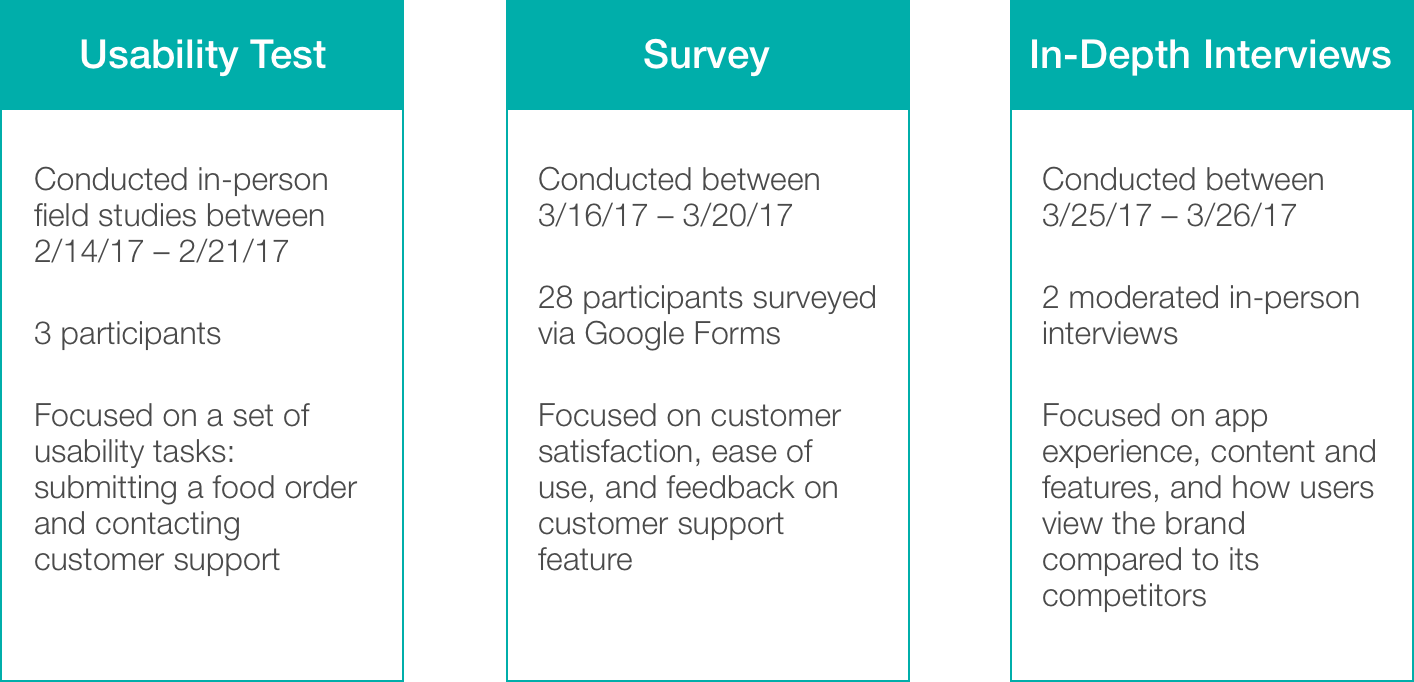POSTMATES USABILITY STUDY
Overview
A User research study to impact postmate’s product development
Online food delivery presents a $210B market opportunity. With ever-increasing competition, it’s extremely important to invest in usability studies to ensure that Postmates keeps abreast of changing user needs and makes the adjustments necessary to maintain its leading position in the competitive market.
Role
Researcher
Strategist
Timeline
10 weeks
Testing Overview
Objectives
Usability goals
Determine design inconsistencies and usability problem areas within the user interface and content areas
Establish baseline user performance and user-satisfaction levels
experience goals
Gain an understanding of users’ needs and preferences related to Postmates services
Determine what features would bring the most benefit to the app and users
Gain insight into how users conduct tasks
Establish what our users think about our brand compared to competitors
User Audience
To best empathize with Postmates users, I conducted my tests with the following participant audience:
Usability Test
OVerview
The usability test was conducted to establish a baseline of user performance and user-satisfaction levels of the user interface, as well as identify potential design concerns.
Usability Objectives/Goals
Being able to search for their desired food/restaurant
Finding the dish(es) they want to order
Adding order to shopping cart
Following through the checkout process for payment
Being able to search for recent order to report a problem
Locating the customer service feature
Creating a support ticket for a missing item
Methodology
The participants will conduct the test in their natural environments through the use of the Postmates app on their smart phones (iPhone or Android). Conducted on 2/14/17-2/21/17.
Participants
Three active Postmates users
Age: 25-40
Household income: $60K-$150K+
Location: San Francisco, CA
Survey
Overview
The survey was conducted to understand Postmates users’ needs, expectations, and overall satisfaction with the app.
Objectives/goals
User satisfaction over time
Ease of use
Feedback on the customer service feature
Understanding demographics of respondents
Methodology
The survey was conducted using Google Forms and consisted of 10 questions, including multiple choice, rate on a scale, ranking, and open ended questions. Conducted on 3/16/17-3/20/17.
Participants
A total of 28 participants completed the survey. Participants were friends and colleagues who actively use the Postmates app on their smartphone — gathered through email, social media, and company Slack channel outreach. All live in either the Bay area or Washington D.C. Metropolitan area, with ages ranging from 22–40 years old.
In-Depth Interviews
Overview
These in-depth interviews were conducted to gain insight into what’s important to Postmates users, what they want from the app, and to identify content and functional requirements.
Objectives/goals
To gain an understanding of Postmates users’ needs
Determine what features would bring the most benefit to our app and users
To gain insight into how users conduct tasks
Establish what users think about our brand compared to our competitors
Determine how we should be engaging our customers
Key research questions
How is the food delivery app experience for Postmates users?
What content and features are most important?
How do users view Postmates compared to its competitors?
Methodology
Two moderated in-person interviews conducted on 3/25/17 and 3/26/17.
Participants
Two active Postmates users
Age: 25-40
Household income: $60K-$150K+
Location: San Francisco, CA
Key Findings
1. Delivery fees
A majority of users had issues with the transparency of delivery fees.
Too expensive
Want to know what the delivery fees are at the start of the order flow
Frustration with surprise surge fees at the end of the checkout process
Recommendation: State up-front on each restaurant page what the delivery fee is for that restaurant so that customers are aware at the start of the order flow.
→ High value: easy to implement
Postmates Check Out Screen
2. Reviews and recommendations
Restaurant reviews and recommendations are important to users, but are currently missing in the app.
Yelp integration and/or restaurant and food recommendations based on previous orders would heighten the user experience
Because of the vast restaurant selection within the app, having a ratings/reviews section would help users in their food selection, as well as broaden their desire to try new places
Recommendation: Include a recommendations section specific to each user’s taste/order history. Also, either implement a user ratings/reviews feature in-app or, if possible, integrate with Yelp.
→ Strategic: more effort to implement
Caviar Home Screen
3. Customer support
Bad experience with customer support can really hinder the overall app experience for users.
Many participants were dissatisfied with the user interface of the feature and experienced problems
Frustration with long response time and lack of consistency with the support personnel for each inquiry
Even if users are refunded for mistakes, orders are still not corrected
Postmates Customer Support
Recommendation: Implement a real-time chat function within the Customer Support feature so that customers will be able to not only receive a credit or refund when there is an issue, but also correct the order in a timely manner.
→ Luxury: costly, more research is needed before this is implemented
Next Steps
Research Objectives/questions
3 month test plan
Reviews & Recs: Blast out survey to gauge user interest and feedback. Then conduct more qualitative IDIs with power users to put together concept ideas for testing. From the concept test, I would then create a prototype and conduct usability testing
Delivery Fees: This test would be shorter, so I could stagger it with the others throughout the 3-month period. I would also start with a survey to gauge concern about the fees. Then I would do an in-app A/B test, which would measure results through another survey to the experimental group about the new experience.
Customer Support: Begin with a survey regarding users’ preferred customer service channel. Then do market research and competitor analysis to identify channels. Based on feedback, I would then pick the most popular one and implement the prototype in a private beta test. Then I would begin the usability test with the prototype.










